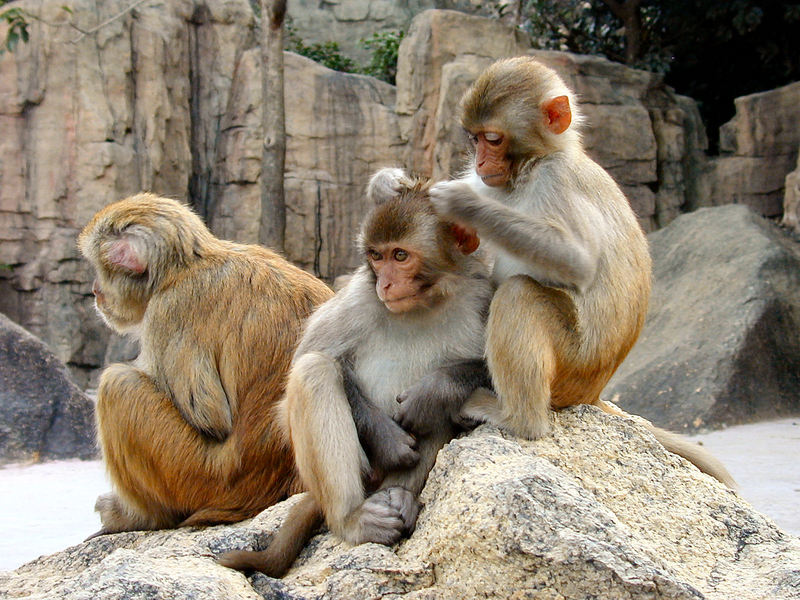|
| 질의: january tetra | 결과: 2번째/2 | |
Rhesus Macaque (Macaca mulatta) - Wiki
| 제목: | Rhesus Macaque (Macaca mulatta) - Wiki
| |

| 해상도: 1600x1200
파일크기: 505057 Bytes
촬영일: 0000:00:00 00:00:00
사진기: E950 (NIKON)
F number: f/2.5
Exposure: 10/930 sec
Focal Length: 190/10
등록시간: 2006:11:28 22:24:58
|
Rhesus Macaque
From Wikipedia, the free encyclopedia
[Photo] Description Rhesus Macaques (Macaca mulatta) from Hainan island, China. Source http://www.sxc.hu/photo/229342 Date Uploaded on 2004-12-26 Author Nikita Golovanov http://www.sxc.hu/profile/kit1578
The Rhesus Macaque (Macaca mulatta), often called the Rhesus Monkey, is one of the best known species of Old World monkeys. It is a typical macaque, common throughout Afghanistan to northern India and southern China. Rhesus Macaques are sexually dimorphic. Adult male Rhesus Macaques measure approximately 53 centimeters on average and weigh an average of 7.7 kilograms. Females are smaller, averaging 47 centimeters in length and 5.3 kilograms in weight. They are brown or grey in color and have pink faces which are typically bereft of fur. Their tails are of medium length and average between 20.7 and 22.9 centimeters. They typically have a lifespan of about 25 years.
In science
The Rhesus Macaque is well known to science owing to its relatively easy upkeep in captivity, and has been used extensively in medical and biological research. It has given its name to the Rhesus factor, one of the elements of a person's blood group, by the discoverers of the factor, Karl Landsteiner and Alexander Wiener. The Rhesus Macaque was also used in the well-known experiments on maternal deprivation carried out in the 1950s by comparative psychologist Harry Harlow. NASA launched Rhesus Macaques into space during the 1950s and 60s.
In January of 2000, the Rhesus Macaque became the first cloned primate with the birth of Tetra. January 2001 saw the birth of ANDi, the first transgenic primate; ANDi carries foreign genes originally from a jellyfish.
The genome of the Rhesus Macaque is currently being sequenced.
Though most studies of the Rhesus Macaque are from various locations in northern India, some of our knowledge of the natural behaviour of the species comes from studies carried out on a colony established by the Caribbean Primate Research Center of the University of Puerto Rico on the island of Cayo Santiago, off Puerto Rico. There are no predators on the island, and humans are not permitted to land except as part of the research programmes. The colony is provisioned to some extent, but about 50% of its food comes from natural foraging. In other more controlled settings, these macaques often enjoy Fig Newtons and apricots, and are particularly keen on "pouching" large quantities of marshmallows.
In nature
Inhabiting arid, open areas, the Rhesus Macaque may be found in grasslands, woodlands, and in mountainous regions up to 2,500 metres in elevation. It is a good swimmer and is said to enjoy the activity. The Rhesus Macaque is noted for its tendency to move from rural to urban areas, coming to rely on handouts or refuse from humans. It has become a pest in some areas, perceived as a possible risk to public health and safety.
A diurnal animal, the Rhesus Macaque is both arboreal and terrestrial; it is mostly herbivorous and feeds on leaves and pine needles, roots, and the occasional insect or small animal. The monkey has specialized pouch-like cheeks, allowing it to temporarily horde its food. The gathered morsels are eaten sometime later, in safe surroundings.
Behaviour and reproduction
Like other macaques, the Rhesus troop comprises a mixture of males and females. The troop may contain up to 180 individuals, but 20 is the average. Females may outnumber the males by a ratio of 4:1. The social hierarchy is also matriarchal, rank dependent on lineage to the lead female. Care of young and territory surveillance duties are shared amongst the troop. While females are more or less placid, males are typically rowdy between themselves. The Rhesus Macaque is characterised as a vociferous monkey. Monkeys that discover food will normally advertise the fact by specific calls, though it has been claimed that young or subordinate monkeys will sometimes seek to avoid doing so if their discovery has gone unobserved. Females cycle similar to humans with menstrual cycles of around 28 days.
Mating is not confined to a specific season. Gestation may last from 135-194 days. Females are mature by three years of age, and males at four. They may live for 30 years or more.
Classification
There are several subspecies of Rhesus Macaque:
Macaca mulatta mulatta
Macaca mulatta villosa
Macaca mulatta vestita
Macaca mulatta lasiota
Macaca mulatta sanctijohannis
Macaca mulatta brevicauda
| The text in this page is based on the copyrighted Wikipedia article shown in above URL. It is used under the GNU Free Documentation License. You may redistribute it, verbatim or modified, providing that you comply with the terms of the GFDL. |
|
^o^
동물그림창고 똑똑전화 누리집
^o^
|
|

